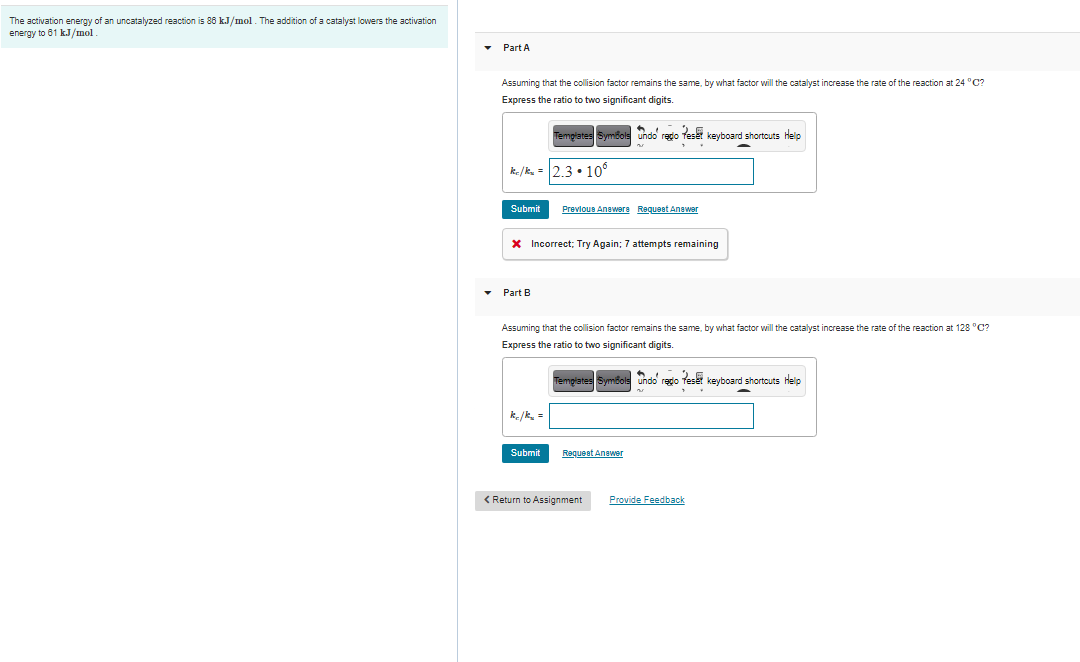The activation energy of an uncatalyzed reaction is 86 k.J/mol. The addition of a catalyst lowers the activation energy to 81 kJ/mol • Part A e of the reaction at 24 "C? Assuming that the colision factor remains the same, by what factor will the catalyst increase the Express the ratio to two significant digits. Templates Symbols undo redo feset keyboard shortouts Help k. /k. - 2.3 • 10° Submit Previous Answer Request Answer X Incorrect; Try Again; 7 attempts remaining • Part B Assuming that the colision factor remains the same, by what factor will the catalyst increase the e of the reaction at 128 "C? Express the ratio to two significant digits. Templates Symbol undo rego feset keyboard shortouts Help k. /k. =
The activation energy of an uncatalyzed reaction is 86 k.J/mol. The addition of a catalyst lowers the activation energy to 81 kJ/mol • Part A e of the reaction at 24 "C? Assuming that the colision factor remains the same, by what factor will the catalyst increase the Express the ratio to two significant digits. Templates Symbols undo redo feset keyboard shortouts Help k. /k. - 2.3 • 10° Submit Previous Answer Request Answer X Incorrect; Try Again; 7 attempts remaining • Part B Assuming that the colision factor remains the same, by what factor will the catalyst increase the e of the reaction at 128 "C? Express the ratio to two significant digits. Templates Symbol undo rego feset keyboard shortouts Help k. /k. =
Chemistry: Principles and Reactions
8th Edition
ISBN:9781305079373
Author:William L. Masterton, Cecile N. Hurley
Publisher:William L. Masterton, Cecile N. Hurley
Chapter11: Rate Of Reaction
Section: Chapter Questions
Problem 71QAP: For a certain reaction, Ea is 135 kJ and H=45 kJ. In the presence of a catalyst, the activation...
Related questions
Question

Transcribed Image Text:The activation energy of an uncatalyzed reaction is 86 kJ/mol. The addition of a catalyst lowers the activation
energy to 81 kJ/mol
Part A
Assuming that the collision factor remains the same, by what factor will the catalyst increase the rate of the reaction at 24 °C?
Express the ratio to two significant digits.
Templates Symbols undo rego feset keyboard shortcuts Help
k./k, = 23•106
Submit
Prevlous Anawers Requeat Anawer
X Incorrect; Try Again; 7 attempts remaining
Part B
Assuming that the collision factor remains the same, by what factor will the catalyst increase the rate of the reaction at 128 °C?
Express the ratio to two significant digits.
Templates SymBols undo redo Teset keyboard shortcuts Help
k/k =
Submit
Request Anewer
< Return to Assignment
Provide Feedback
Expert Solution
This question has been solved!
Explore an expertly crafted, step-by-step solution for a thorough understanding of key concepts.
Step by step
Solved in 3 steps with 2 images

Knowledge Booster
Learn more about
Need a deep-dive on the concept behind this application? Look no further. Learn more about this topic, chemistry and related others by exploring similar questions and additional content below.Recommended textbooks for you

Chemistry: Principles and Reactions
Chemistry
ISBN:
9781305079373
Author:
William L. Masterton, Cecile N. Hurley
Publisher:
Cengage Learning

Chemistry: The Molecular Science
Chemistry
ISBN:
9781285199047
Author:
John W. Moore, Conrad L. Stanitski
Publisher:
Cengage Learning

Chemistry by OpenStax (2015-05-04)
Chemistry
ISBN:
9781938168390
Author:
Klaus Theopold, Richard H Langley, Paul Flowers, William R. Robinson, Mark Blaser
Publisher:
OpenStax

Chemistry: Principles and Reactions
Chemistry
ISBN:
9781305079373
Author:
William L. Masterton, Cecile N. Hurley
Publisher:
Cengage Learning

Chemistry: The Molecular Science
Chemistry
ISBN:
9781285199047
Author:
John W. Moore, Conrad L. Stanitski
Publisher:
Cengage Learning

Chemistry by OpenStax (2015-05-04)
Chemistry
ISBN:
9781938168390
Author:
Klaus Theopold, Richard H Langley, Paul Flowers, William R. Robinson, Mark Blaser
Publisher:
OpenStax


Chemistry
Chemistry
ISBN:
9781305957404
Author:
Steven S. Zumdahl, Susan A. Zumdahl, Donald J. DeCoste
Publisher:
Cengage Learning

Chemistry: An Atoms First Approach
Chemistry
ISBN:
9781305079243
Author:
Steven S. Zumdahl, Susan A. Zumdahl
Publisher:
Cengage Learning